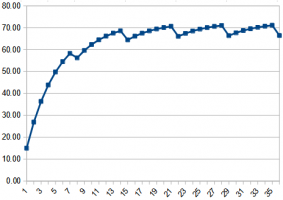Everyday of the week i consume 15mg but one day i consume only 10mg, the half life of the substance is 3 days. I want to know how much of it is in my body after 5 weeks but that would take ages to calculate because i would have to calculate day by day with this formula:
N(t) = N(0) * 0.5^(t/T)
where N(0) is the initial amount, t is elapsed time (in days) and T is the half life (in days). I would input 15 then get 11.9 and add 15 to get 26,9 then that would calculate to 21,35 , that would take ages to do 35 times so i came here for help for a formula
N(t) = N(0) * 0.5^(t/T)
where N(0) is the initial amount, t is elapsed time (in days) and T is the half life (in days). I would input 15 then get 11.9 and add 15 to get 26,9 then that would calculate to 21,35 , that would take ages to do 35 times so i came here for help for a formula
Last edited by a moderator:


